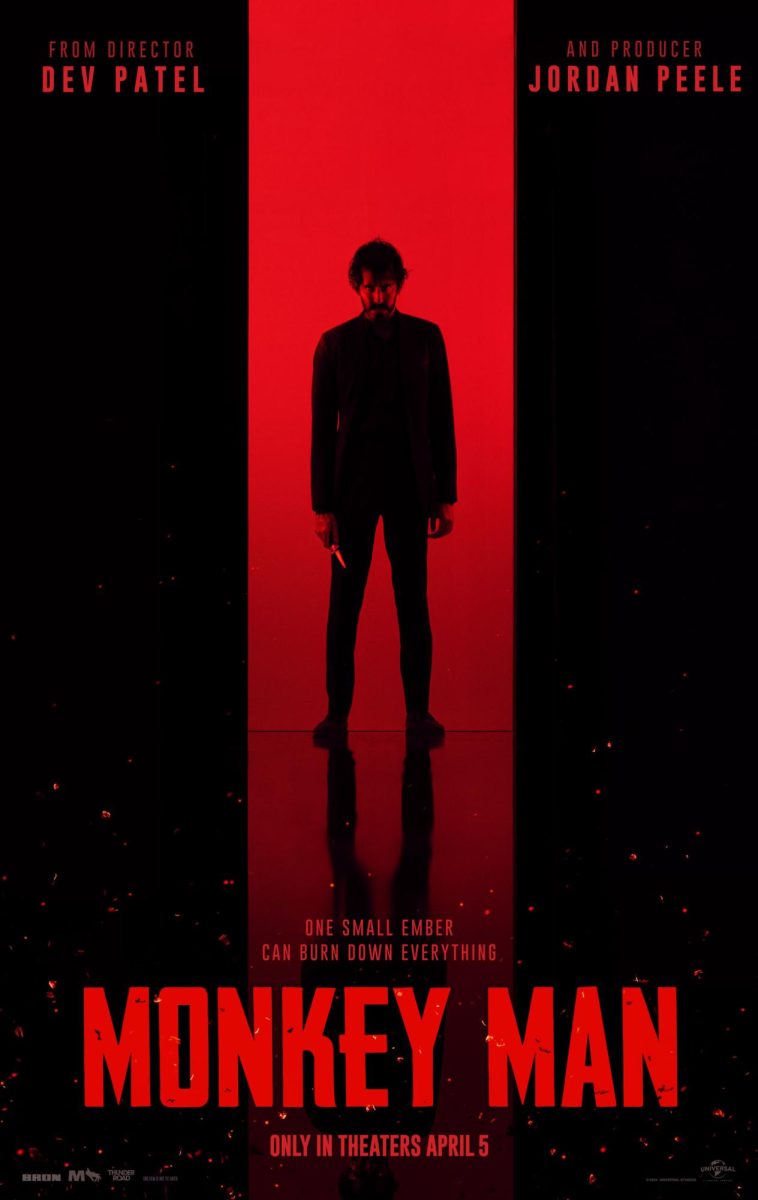“Monkey Man,” an early April released action/thriller, follows the main character — played by director and co-writer Dev Patel — as he navigates and realizes his past, taking revenge and fixing the future.
He said:
“Monkey Man” is interesting in the way it seems incredibly familiar yet still unique. It was a film that constantly reminded me of other media, yet somehow still maintained this notion of originality that kept me engaged.
Ever since the first trailer dropped, news outlets have been comparing it to the “John Wick” franchise on account of its stylish combat. While it is true the film has beautifully choreographed action sequences reminiscent of Keanu’s iconic character, in many respects “Monkey Man” seems like a subversion of John Wick.
This subversion ironically comes from the way “Monkey Man” features a far more traditional character arc. We see the Monkey Man go from barely surviving fights to becoming a deadly force of nature. We also see Monkey Man’s personal journey of revenge become one that takes on a greater societal purpose.
This contrasts with Wick, as he is an unstoppable killing machine from start to finish whose vendetta never really concerns anyone but himself.
However, in the grand scheme of action heroes, arguably the “ass kicked” to “ass kicker” is generic compared to a perpetual badass like Wick.
The way “Monkey Man” really separates itself is through its style and setting. It explores India and the mythology of Hinduism which isn’t often represented in Hollywood. The way it depicts religious and political tensions and Hindu folklore provides a lot of interest for those unfamiliar with that region of the world.
Where I think the film falls short is its second act. This second act can almost be seen as a training montage scene from any good sports film. The problem with this is it delves too deeply into the Monkey Man’s personal backstory.
Up until this point we had seen cryptic flashbacks of his past. This act serves to spell it all out, yet also sets up the notion that this personal struggle doesn’t matter, but that the Monkey Man’s personal revenge is part of a greater issue.
While I believe his whole past is shown largely to emphasize the parallels between Monkey Man and the mythological tale of Hanuman, the Hindu deity he is based on, it takes away the ambiguity and mystique behind the character.
The film returns to form with its concluding act showing the Monkey Man coming back stronger to fight not just for himself, but everyone who has suffered like him. The film’s conclusion pulls to a close a good story but still feels marred by issues in the second act.
She said:
Why does it seem like all action movies start with two guys beating each other up?
In “Monkey Man,” I do have to appreciate that the action and violence that occurs is not needless, at least at the beginning. I also appreciate the realism infused in the film, for example, the main character attempts to jump out of a window … which does not break.
Additionally, the main character, who hatches a great plan for revenge, starts out as a really terrible fighter, which also adds to the sense of realism.
Then, of course, he gains his footing as a dangerous and focused fighter in the second act through a training montage after he takes a drug trip … as all good fighters do apparently.
As inspiring as the montage is, I found the hijras to be the most interesting. The hijras were introduced after Alpha, the temple’s caretaker, rescued the main character after he was severely injured and on the run from the police.
Most action films choose to avoid topics like these, but “Monkey Man” leans more toward specific cultural and religious themes. This ties into the main character’s story of revenge.
He wanted revenge against the police and their chief after they burned his village. The battle between religions and against indigenous people is noted multiple times throughout the film.
His backstory is revealed through a series of artful flashbacks that reveal the difference between then and now. The tone, scenery and color scheme of the shots also exaggerate the difference between the two.
The tale of revenge told throughout the film differs from others, in that the main character toward the end finally realizes that there’s more to it than himself and the moment. He realizes that his revenge is tied to a greater problem, and he’d be saving numerous people by taking out the right people.
However, as the main character finally gets to exact his revenge, the scene seems muddled. His emotions were caught between being emotionless, enraged and saddened.
The ending was also a strange mix of catharsis and dissatisfaction.
“Monkey Man” is still in some theaters and is available for rent or purchase on Prime Video.
Garrett Hartman and Ariana Powell can be reached at orionmanagingeditor@gmail.com.
Ariana Powell can also be reached at alpowell1@csuchico.edu.







